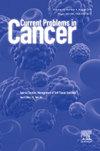Angiogenesis biomarkers in prostate cancer: Unlocking new avenues for prognosis and diagnosis
IF 2.3
4区 医学
Q3 ONCOLOGY
引用次数: 0
Abstract
Objective
To evaluate the levels of angiogenesis-related biomarkers, including Thrombospondin-1 (TSP1), Endostatin, Osteopontin, and Tumstatin, in prostate cancer patients and their relationship with tumor spread and clinical parameters.
Methods
This prospective study included 92 participants divided into three groups: 33 prostate cancer patients, 29 patients with benign prostatic hyperplasia (BPH), and 30 healthy controls. Biomarker levels were analyzed and compared among the groups.
Results
Osteopontin levels were significantly higher in the prostate cancer group (108.5 ng/mL) compared to the BPH (66.02 ng/mL) and control groups (56.5 ng/mL). TSP1 levels were lower in prostate cancer group (16.3 ng/mL) than in the BPH (25.3 ng/mL) and control groups (21.5 ng/mL). Similarly, Endostatin levels were reduced in the prostate cancer group (146.3 ng/mL) compared to the BPH (163.3 ng/mL) and control groups (166.2 ng/mL). No significant differences in Tumstatin levels were observed among the groups.
Conclusions
Elevated Osteopontin levels correlate with higher Gleason scores and metastatic potential, while lower TSP1 and Endostatin levels are associated with advanced tumor progression. These biomarkers may serve as indicators of prognosis in prostate cancer, though larger studies are required for validation.
前列腺癌血管生成生物标志物:为预后和诊断开辟新的途径。
目的:探讨前列腺癌患者血管生成相关标志物血栓反应蛋白-1 (TSP1)、内皮抑素(Endostatin)、骨桥蛋白(Osteopontin)和Tumstatin的水平及其与肿瘤扩散和临床参数的关系。方法:这项前瞻性研究包括92名参与者,分为三组:33名前列腺癌患者,29名良性前列腺增生(BPH)患者和30名健康对照。分析并比较各组生物标志物水平。结果:前列腺癌组骨桥蛋白水平(108.5 ng/mL)明显高于前列腺增生组(66.02 ng/mL)和对照组(56.5 ng/mL)。前列腺癌组TSP1水平(16.3 ng/mL)低于BPH组(25.3 ng/mL)和对照组(21.5 ng/mL)。同样,前列腺癌组内皮抑素水平(146.3 ng/mL)低于BPH组(163.3 ng/mL)和对照组(166.2 ng/mL)。各组间Tumstatin水平无显著差异。结论:骨桥蛋白水平升高与较高的Gleason评分和转移潜力相关,而较低的TSP1和内皮抑素水平与晚期肿瘤进展相关。这些生物标志物可以作为前列腺癌预后的指标,但需要更大规模的研究来验证。
本文章由计算机程序翻译,如有差异,请以英文原文为准。
求助全文
约1分钟内获得全文
求助全文
来源期刊

Current Problems in Cancer
医学-肿瘤学
CiteScore
5.10
自引率
0.00%
发文量
71
审稿时长
15 days
期刊介绍:
Current Problems in Cancer seeks to promote and disseminate innovative, transformative, and impactful data on patient-oriented cancer research and clinical care. Specifically, the journal''s scope is focused on reporting the results of well-designed cancer studies that influence/alter practice or identify new directions in clinical cancer research. These studies can include novel therapeutic approaches, new strategies for early diagnosis, cancer clinical trials, and supportive care, among others. Papers that focus solely on laboratory-based or basic science research are discouraged. The journal''s format also allows, on occasion, for a multi-faceted overview of a single topic via a curated selection of review articles, while also offering articles that present dynamic material that influences the oncology field.
 求助内容:
求助内容: 应助结果提醒方式:
应助结果提醒方式:


